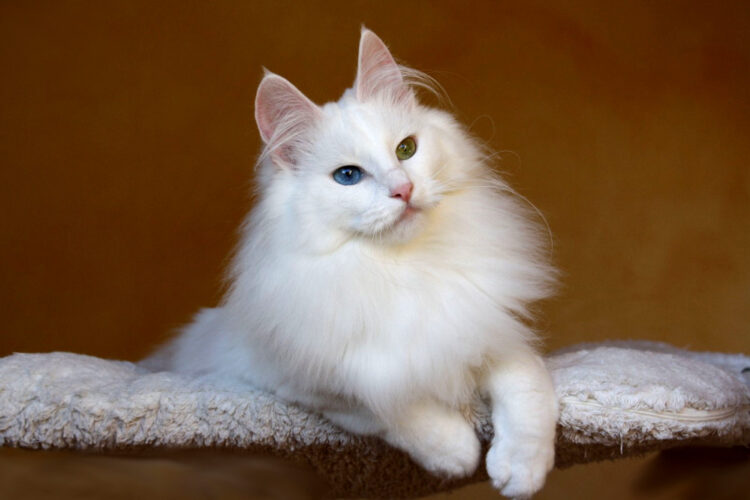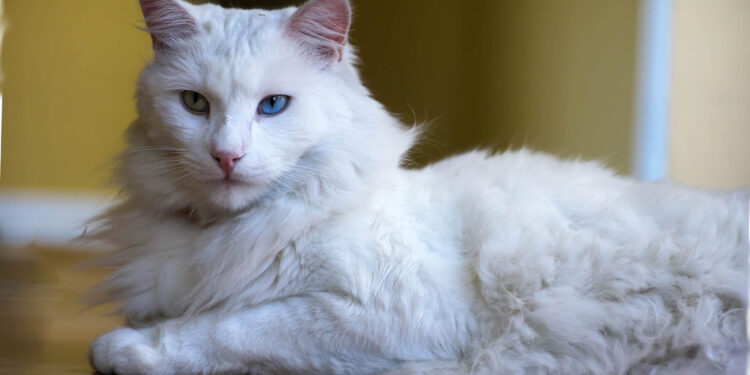When talking about pedigree cats, many people think of Persian cats first. This is not so far-fetched, since the Persian is the pedigree cat with the longest breeding history.
origin
The Turkish Angora cat is medium-sized with medium-length hair. It is one of the oldest cats in the world and is one of the naturally created breeds. Its name indicates twice that the cat comes from Turkey. Angora is the old name of today’s capital Ankara. But that doesn’t tell the whole story of the origin of the Turkish Angora cat. About 50 years ago, all long-haired cats were still called Angora cats. The Turkish Angor cat then had its absolute peak in the 16th century, before “Persian” prevailed as the name for the long-haired cats. Today the Persian cats are known everywhere as classic longhair cats.
The first Angora cat was introduced to Europe from Asia in the 17th century.
Two white Angora cats from Ankara Zoo were allegedly used for this purpose.
Looks

The Turkish Angora cat is a medium-sized cat breed that has a very elegant and slender build. Her movements are fluid and confident. The Turkish Angora cat is muscular but has a fine build with no pronounced chest. An Angora cat can weigh 3-5 kilos. The cat’s paws are small and dainty. Their tail is large and bushy, wider than the build, and meant to be carried proudly and majestically. The fur of the Turkish Angora cat is very soft and medium long, and there is no felty undercoat.
At that time, only a pure white coat color was allowed for Turkish Angora cats. However, this coat color arose from a genetic defect that caused serious physical illnesses such as blindness, deafness, and balance disorders. That’s why other coat colors are allowed today
character and essence
The Turkish Angora has a very friendly and gentle nature. She can develop a close bond with people and is very suitable for people who want to enjoy peace and relaxation together with their cats. The Turkish Angora cat is a family cat that knows its people very well and is also particularly attentive.
In addition, she is also very social, she loves life with people. Even hustle and bustle can’t upset you that easily. The Turkish Angora cat likes to exercise in nature, but can also be kept exclusively in the apartment. They have a very calming demeanor and are also very affectionate. Despite the attachment, they don’t let themselves be taken in and retain their own proud personality.
attitude
The Turkish Angora cat is the perfect house cat for the apartment. It is very undemanding in its keeping conditions if healthy breeding is required. She is constantly looking for an intimate relationship with her owners and is a very affectionate family cat. In order to feel completely comfortable, she does not have to be an outdoor cat. The Turkish Angora cat gets along very well with children and other pets and is extremely sociable.
care and health
You should brush your Angora cat’s fur regularly. You should make sure that you brush the fur regularly, especially when the fur is changing. For example, brushing can become a daily ritual that strengthens the bond between you and your cat.
When it comes to nutrition, you don’t need to worry too much, the Turkish Angora cat is very undemanding and, by cat standards, an easy border.
Read Also: Siberian forest cat
Breed diseases
Turkish Angora cat breeds can suffer from severe inbreeding. These inbreedings very often lead to immune deficiencies and illnesses that greatly reduce life expectancy. This breed can also suffer from a number of hereditary diseases that are common in breeding, such as ataxia, where movement is disturbed. Some coat colors can lead to health problems. Hereditary diseases such as deafness, blindness, and balance disorders can occur, especially with the pure white coat color.
Did you know already?

It was only around 1600 that long-haired Turkish “Angora” or “Persian” cats were officially allowed to be exported from Turkey; before that, they only reached the European princely courts unofficially via travelers from the Middle East.
FAQs
How Big Do Turkish Angoras Get?
The average size of the Turkish Angora cat is between 30 and 35 cm.
How old do Turkish Angora cats get?
Turkish Angora cats live approximately 12 to 18 years.
How much does a Turkish Angora cost?
A Turkish Angora costs around 800 euros.
When is a Turkish Angora fully grown?
As a rule, a Turkish Angora is fully grown at the age of 2 years.




